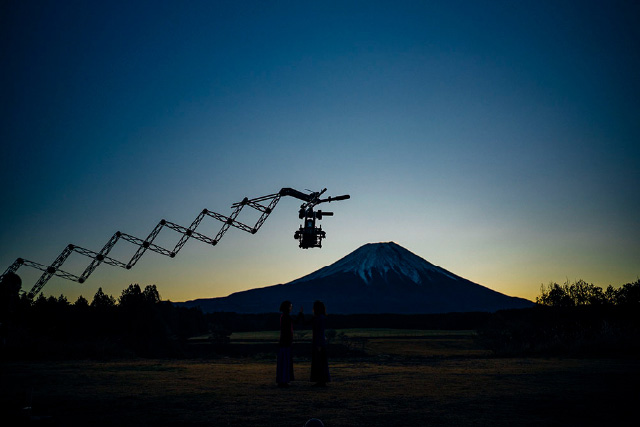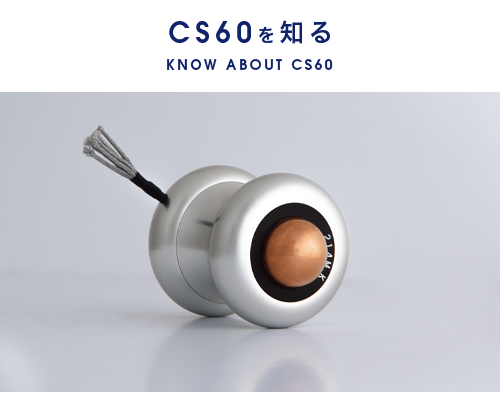
- 2019/12/26
-
Newsletter Vol.38
カメラマン・中村祥一さんインタビュー(後編)
Interview with Cameraman Shoichi Nakamura (Part II)
Interview avec le photographe Shoichi Nakamura (Dernière partie)  今回もCS60の写真撮影や映像制作を担当する、カメラマンの中村祥一さんにインタビューしました。
今回もCS60の写真撮影や映像制作を担当する、カメラマンの中村祥一さんにインタビューしました。
――――――――――――
―中村さんは西村先生と同行して世界中を回っています。その中で印象に残っている施術はありますか?中村:インドのダラムサラに行ったときは、チベット仏教の高僧に、「効果が感じられなければ、すぐ帰ります」という条件だったので、緊張感がありました。
それから、カンヌ国際映画祭です。―どんな発見がありましたか?
中村:施術の良し悪しというのは、日本人よりも、海外の自立している人たちのほうがわかりやすいのです。国際映画祭に集まるセレブは、世界中のいろいろなものを見ているので、本物と偽物の区別がつけられます。「本物を知っているプロのエンターテイナーや、人生経験の豊富な人たちにCS60がどれくらい魅力的に映るのか」ということが見られて楽しかったです。
―CS60は言葉で説明するのが難しいものですが、中村さんはどのようにとらえていますか?
中村:僕は物理学や量子力学が好きで、大学では理系を専攻していました。
その観点から、最近、昔はオカルトと言われていた事象とサイエンスの分野がどんどん融合してきていると感じています。原理主義的、思考停止したスピリチュアル的な視点でCSを見る方も中にはいるかもしれませんが、そうではなく、本来の意味での霊的、スピリチュアル的な考えだと、肉体は幻で、精神が肉体を作っているという考え方もあります。唯物論の逆の考え方です。そのことを真面目に研究している科学者たちもいます。そのグレーゾーンにCS60もあると思って、自分でもさまざまな仮説を検証しているところです。―肉体が幻だとすると、痛みなどの感覚はどこから発生しているのでしょうか。
中村:一説には、「思考が痛みをつくっている」と考えられています。プログラミングでいうとバグのようなものです。CS60はそこにアプローチして細胞をリセットすることで、痛みをかき消すというのが僕の仮説です。このような仮説を何本も立てて、その場、その場で、イメージをふくらませるのも楽しいですね(笑)。
―「自分とは何か」を考えさせられる、哲学的なお話ですね。
中村:近年「自分のアイデンティティとは何なのか」ということに世界中の関心が集まっていて、それをテーマにした映画も増えています。
例えば、『ウエストワールド』という海外ドラマでは西部劇の世界が舞台です。
全員自分たちがこの世界に生きていると思っているんですけど、実は人工知能で、テーマパークのように、外の人間が入って遊ぶために用意された登場人物なんです。彼ら(ロボット)が、そういった作られた世界のループからどうやって抜け出すか、という物語なんですが、これって、「輪廻転生からの解脱」という、かなり、宗教的要素が強いテーマなんです。娯楽要素の強い海外ドラマをそこまで来たか、という衝撃を受けました。(シーズン3は来年配信予定)『インターステラー』や『マトリックス』もそういう物語かもしれません。
そういったあくまで想像上のイメージを、CSでは仮体験できるように感じています。(おわり)
This time we will be interviewing cameraman Shoichi Nakamura, who handles photography and audiovisual production for CS60.
――――――――――――– So, you’re going around the world following Dr. Nishimura. Were there any treatments in those travels that particularly stand out to you?
Nakamura: In Dharamshala, India, we spoke to a Tibetan Buddhist prelate, who gave us the condition that if he couldn’t feel anything he would leave immediately, which was nerve-wracking.
After that was the Cannes Film Festival.– What did you discover?
Nakamura: Relatively independent-minded foreigners were better than Japanese people at telling good from bad with the treatments. At the Cannes Film Festival, where there were a lot of celebrities, the people who traveled the world seeing all kinds of things could tell straight away if something was a fake. It was great to see how attractive the CS60 was for pro entertainers who could tell the real thing when they saw it, or for people with a rich life experience.
– The CS60 is hard to explain in words. How do you go about talking about it to people?
Nakamura: I am really interested in physics and quantum mechanics, so when I was at university, I majored in a STEM field. From that perspective, it seems to me that what used to be called the occult and science are gradually merging into one another.
There are probably some number of people who look at CS from a fundamentalist, unthinking point of view. But I think there is also a way of thinking that if you take incorporeality and spiritual ideas in their original sense, the physical is spirit, and the mental creates the physical. It is the opposite way of thinking to materialism. There are scientists seriously studying this. I think the CS60 exists in a similar gray zone, and I am personally exploring a number of hypotheses along those lines.– If we treat the physical body as spirit, what do you think is the origin of the sensation of pain etc.
Nakamura: One theory is that thought creates pain. In programming terms it is a bug. One hypothesis of mine is that the CS60 approaches that and resets the cells in order to erase the pain. I have a number of hypotheses likes this, and expanding my image with them at each place is fun!
– That’s very philosophical talk, thinking about “what the self is.”
Nakamura: In recent years the issue of what your identity is has garnered a lot of attention across the world, and the number of films on that theme is increasing.
For example, the foreign TV show Westworld is set in a Western-style world. Everyone in the show thinks that they are really living in that world, when they are actually artificially intelligences living in something like a theme park for humans to come a visit for their amusement.
The story of how they (the robots) can escape from this loop is in a sense a story of “the escape from the cycle of life and rebirth,” which is a theme with strong religious elements. I was pretty impressed that foreign, mass-entertainment TV shows have gotten so advanced. (Season 3 is due out next year). Interstellar and The Matrix I would also put in the same category. These sorts of fundamentally imaginary things are something I feel CS lets you get a kind of experience of.(End)
Nous avons interviewé le photographe Shoichi Nakamura qui est chargé des photographies et des montages des vidéos du CS60.
――――――――――――– Vous accompagnez le Professeur Nishimura dans le monde entier.
Est-ce que vous avez des sessions de traitement qui vous ont frappées ?Nakamura : Lorsque nous sommes allés à Dharamsala, un moine bouddhiste tibétain nous a dit qu’il allait rentrer tout de suite chez lui s’il ne ressentait pas les effets. Nous étions donc tendus.
Des sessions de traitement à l’occasion du festival de Cannes ont été aussi impressionnantes.– Qu’est-ce que vous y avez découvert ?
Nakamura : Les étrangers indépendants comprennent mieux que les Japonais ce que sont les bons traitements.
Les célébrités qui étaient présentes au festival ont déjà vu différentes choses dans le monde entier alors elles sont capables de distinguer le vrai du faux.
J’ai pu constater à quel point les artistes professionnels, les gens avec beaucoup d’expériences et qui connaissent des choses authentiques trouvent le CS60 attirant. C’était intéressant.– C’est difficile d’expliquer le CS60 avec les mots. Comment comprenez-vous le CS60 ?
Nakamura : J’aime bien la physique et la mécanique quantique. J’ai étudié la science dure à l’université. J’ai l’impression que les sciences et les phénomènes de l’ordre de l’occultisme fusionnent de plus en plus. Il y a surement des gens qui regardent le CS60 d’un point de vue fondamentaliste ou d’un point de vue spirituelle. Cependant, dans la spiritualité au sens propre, le corps est une illusion et c’est l’esprit qui fait le corps. C’est l’idée inverse du matérialisme. Il y a même des scientifiques qui font les recherches sérieusement sur ce sujet. Je pense que le CS60 est situé au milieu entre le matérialisme et la spiritualité. Je vérifie maintenant différentes hypothèses.
– Si le corps est une illusion, d’où proviennent les douleurs ?
Nakamura : Il y a une théorie selon laquelle c’est notre pensée qui crée des douleurs.
C’est comme des bugs informatiques dans le domaine de la programmation.
Je suppose que le CS60 réinitialise des cellules en accédant aux pensées puis efface les douleurs.
C’est intéressant de formuler plusieurs hypothèses et de les imaginer à chaque session de traitement (lol).– C’est une histoire philosophique qui nous fait réfléchir sur la question : « qui suis-je ? »
Nakamura : Nous sommes aujourd’hui intéressés par la question de notre identité. Il y a de plus en plus de films qui traitent cette question.
Je prends un exemple. « Westworld » est une la série télévisée américaine dont les scènes se passent dans un monde western.
Dans ce film, tout le monde pense qu’ils vivent eux-mêmes dans ce monde. Cependant en réalité ils sont tous des intelligences artificielles, des personnages créés pour servir d’amusement à d’autres personnes. Dans la série, les robots essaient de sortir du monde créé par les gens : une telle histoire est effectivement identique à la « libération de l’âme de l’incarnation » qui est un thème assez religieux. J’ai été étonné par le fait qu’une série télévisée qui est normalement un divertissement traite de ce type de sujet (la troisième saison sera diffusée l’année prochaine). Je pense qu’« Interstellar » et « Matrix » traitent également de ce même type de sujet.
J’ai l’impression que grâce au CS60, nous pouvons provisoirement expérimenter un tel imaginaire.(Fin)
INDEX















